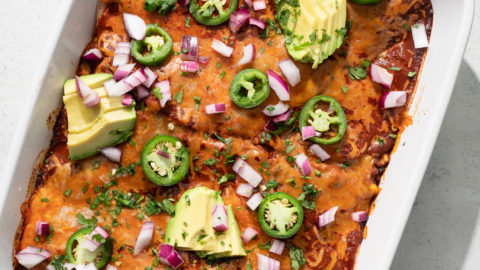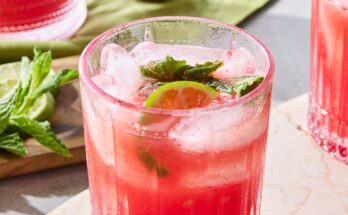Vegetarian Enchilada Recipe: Looking for a hearty, flavorful, and meat-free dish that will win over even the biggest meat lovers at the table? Vegetarian enchiladas are your answer. Packed with rich spices, a medley of vegetables, and topped with gooey cheese and savory enchilada sauce, this dish proves that you don’t need meat to satisfy your cravings. Whether you’re cooking for a family dinner, prepping for the week, or throwing a casual dinner party, this vegetarian enchilada recipe hits all the right notes—delicious, healthy, and easy to customize.
In this detailed step-by-step guide, we’ll walk through every phase of making the ultimate vegetarian enchiladas. From the essential ingredients to pro kitchen tips, you’ll have everything you need to make enchiladas that are mouthwatering, satisfying, and 100% meat-free.
What Makes Enchiladas So Irresistible?
Enchiladas are the kind of dish that instantly brings comfort. Originating from Mexican cuisine, enchiladas are traditionally corn tortillas rolled around a filling and then topped with a savory chili sauce. They can be filled with just about anything—meat, beans, cheese, veggies—and baked to bubbly perfection. It’s the perfect marriage of texture and flavor: soft tortillas, saucy coating, cheesy topping, and a warm, savory filling that oozes deliciousness in every bite.
What makes enchiladas stand out is how adaptable they are. You can mix up the fillings, spice levels, sauces, and even tortillas. Their versatility allows you to cater them to different dietary needs, making them the go-to recipe for many households.
Why Go Vegetarian with Your Enchiladas?
Choosing a vegetarian version of enchiladas is not only a great way to reduce meat consumption but also an opportunity to pack your meal with fiber, antioxidants, and vitamins. Vegetables like bell peppers, mushrooms, spinach, and zucchini provide a variety of textures and nutrients. Add in plant-based protein sources like black beans or quinoa, and you’ve got a filling and satisfying dish that doesn’t skimp on flavor.
Going vegetarian can also be lighter on the digestive system and more heart-healthy, depending on how it’s prepared. Plus, vegetarian enchiladas are a crowd-pleaser, even for meat-eaters—when done right, nobody misses the meat.
Ingredients You’ll Need
Fresh Vegetables
Let’s start with the stars of the show—the veggies. A good enchilada is loaded with color, texture, and layers of flavor, which all begin with fresh vegetables. Here’s what you’ll want to grab:
- Red and green bell peppers – Sweet and slightly crunchy.
- Onions – White or red, adds depth and sweetness.
- Zucchini or yellow squash – Great for volume and mild flavor.
- Mushrooms – Add a “meaty” texture and umami.
- Spinach or kale – Leafy greens that cook down easily.
- Corn (fresh or frozen) – Adds sweetness and pop.
You can swap or skip based on seasonality and preference, but ideally, aim for at least 3–5 kinds for maximum flavor complexity.
Pantry Staples and Spices
The flavor magic happens with the right combination of spices. Mexican cuisine is known for its bold spice blends that bring depth and heat. Here’s what you’ll need from the pantry:
- Black beans or pinto beans – Canned or pre-cooked.
- Olive oil – For sautéing your veggies.
- Garlic – Fresh minced for best flavor.
- Cumin – Earthy, warm, and essential.
- Chili powder – Adds heat and smoky flavor.
- Paprika – Smoked or sweet, adds color.
- Salt & pepper – Basic but crucial.
You can also add optional extras like ground coriander, chipotle powder, or even taco seasoning if you’re short on individual spices.
Sauces and Tortillas
The enchilada sauce and tortillas are what bind the whole dish together.
- Corn tortillas (traditional) or flour tortillas (for a softer bite)
- Enchilada sauce – Store-bought is fine, but homemade is best (more on this soon).
- Shredded cheese – Cheddar, Monterey Jack, or a Mexican blend works best.
If you’re vegan, you can use plant-based tortillas and non-dairy cheese alternatives.
Optional Toppings and Add-Ons
Take your enchiladas over the top with these extras:
- Sour cream or Greek yogurt
- Chopped fresh cilantro
- Avocado slices or guacamole
- Lime wedges
- Sliced jalapeños for heat
- Hot sauce
These aren’t mandatory, but they add texture, freshness, and presentation value.
Kitchen Tools Required
Prep Tools
You don’t need a fancy kitchen setup to make enchiladas, but having the right tools makes the job easier.
- Cutting board and sharp knife – For prepping all those beautiful veggies.
- Can opener – If you’re using canned beans or enchilada sauce.
- Mixing bowls – To mix your filling and prep ingredients.
Cooking and Baking Essentials
- Large skillet or sauté pan – For cooking down the vegetables and filling.
- Spatula or wooden spoon – To stir without scratching your pan.
- 9×13 inch baking dish – Perfect size for baking a batch of enchiladas.
- Foil – To cover while baking to avoid over-browning.
And that’s pretty much it. This recipe doesn’t require a food processor or high-end gear—just some basics, a bit of time, and lots of flavor.
Preparing the Ingredients
Washing and Chopping Vegetables
Before anything hits the pan, let’s prep the produce. Washing and chopping your vegetables ahead of time not only makes the cooking process smoother but also helps you stay organized. Dice your onions and peppers into small, uniform pieces so they cook evenly. Mushrooms should be sliced (not too thin), and greens like spinach should be roughly chopped.
If using zucchini, make sure to remove excess water by patting them dry—zucchini can release a lot of moisture during cooking, which can make your enchiladas soggy if not handled properly.
Set all your chopped ingredients aside in small bowls or on a tray for easy access when it’s time to cook.
Prepping Beans and Grains
If you’re using canned beans, rinse and drain them thoroughly to remove excess sodium. Want to add quinoa or rice to the filling? Cook these in advance so they’re ready to mix in. Quinoa adds a nutty texture and extra protein, while rice helps bulk up the dish for heartier appetites.
You can even mash a few of the beans to create a creamier texture in the filling—it’s all about finding that perfect bite.
Making the Enchilada Sauce (Optional)
Homemade enchilada sauce takes just 10 minutes and can elevate your enchiladas to restaurant-quality. Here’s a quick rundown if you’re up for it:
Ingredients:
- 2 tbsp oil
- 2 tbsp flour
- 1/4 cup chili powder
- 1 tsp garlic powder
- 1 tsp cumin
- 1/2 tsp oregano
- 2 cups vegetable broth
- Salt to taste
Instructions:
- Heat oil, whisk in flour to form a roux.
- Add spices and whisk until fragrant.
- Slowly pour in broth while whisking.
- Simmer 5–7 minutes until thickened.
Voila! Now you’re ready to move to the real fun: assembly and baking.
Step-by-Step Guide to Making Vegetarian Enchiladas
Step 1: Sauté the Veggies
Let’s get to the heart of the recipe—actually putting everything together. This is where the flavors blend, textures come alive, and your kitchen starts smelling amazing. Follow these steps closely, and you’ll have a tray of golden, bubbling vegetarian enchiladas in no time.
Step 2: Prepare the Filling
Heat 2 tablespoons of olive oil in a skillet over medium heat. Add onions, bell peppers, zucchini, corn, and spinach. Sauté for 5–7 minutes, until softened and fragrant. Season with salt, pepper, garlic powder, and a pinch of cumin.
Step 3: Warm the Tortillas
Transfer the sautéed veggies to a bowl. Add black beans, cooked rice or quinoa, and a bit of shredded cheese (optional for extra creaminess). Mix well until evenly combined.
Lightly warm corn or flour tortillas on a skillet for a few seconds per side. This makes them soft and easy to roll without tearing.
Step 4: Fill and Roll the Enchiladas
Spoon the filling into the center of each tortilla, roll tightly, and place seam-side down in a greased baking dish.
Step 5: Add Sauce and Cheese
Pour enchilada sauce (store-bought or homemade) evenly over the rolls and sprinkle with cheese or a vegan alternative.
Step 6: Bake to Perfection
Bake at 375°F (190°C) for 20–25 minutes, until bubbly and golden.
Step 7: Garnish and Serve
Top with fresh cilantro, avocado slices, or sour cream. Serve warm—flavor-packed, hearty, and completely satisfying!
Serving Suggestions
What to Serve with Vegetarian Enchiladas
To make your enchilada meal feel complete, pair it with sides that complement its bold flavors without overwhelming them. Here are some perfect pairings:
- Mexican Rice – A tomato-based rice dish that absorbs all the sauce and flavors beautifully.
- Refried Beans – Creamy and savory, great for scooping up with enchiladas.
- Corn Salad – Fresh and crunchy with lime, cilantro, and avocado.
- Chips and Salsa – Classic starter or side.
- Simple Green Salad – Dressed with lime vinaigrette for balance.
Looking to impress guests? Serve your enchiladas with a refreshing drink like a margarita, agua fresca, or a cold Mexican beer. Don’t forget dessert—churros or flan would seal the deal.
How to Store Leftovers
Let’s face it—enchiladas are one of those meals that taste even better the next day. The flavors deepen, the sauce soaks into the tortillas, and everything melds together beautifully. But storing them properly is key to keeping them tasting great.
Once the enchiladas have cooled to room temperature, transfer leftovers into an airtight container. If you’ve baked them in a glass or ceramic dish, you can also just wrap the whole dish tightly with foil or plastic wrap and refrigerate it. They’ll keep well in the fridge for up to 4–5 days.
If you plan on making these ahead of time for meal prep, you can assemble them (with sauce and cheese) and refrigerate them unbaked for up to 24 hours. Just pop them into the oven when you’re ready to eat—add an extra 10–15 minutes to the bake time to ensure they’re heated through.
Reheating for Best Results
Reheating enchiladas can be tricky if you want to avoid sogginess or dried-out edges. Here are a few foolproof methods:
Oven (Best Method):
- Preheat to 350°F (175°C).
- Cover enchiladas with foil to retain moisture.
- Bake for 20–25 minutes, or until heated through.
- Uncover for the last 5 minutes if you want the cheese a little bubbly and browned.
Microwave (Quick Method):
- Place individual enchiladas on a microwave-safe plate.
- Cover with a damp paper towel.
- Microwave on medium heat for 1–2 minutes, or until hot.
Tip: If microwaving, drizzle a little extra sauce over the enchiladas to prevent them from drying out.
Freezing Instructions:
Vegetarian enchiladas are freezer-friendly too. Wrap them tightly with plastic wrap and foil, or store in a freezer-safe container. They’ll last up to 3 months.
To reheat from frozen, bake at 375°F (190°C) for 40–50 minutes, covered, until hot in the center. Or thaw overnight in the fridge and reheat as described above.
Health Benefits of Vegetarian Enchiladas
Nutrient-Rich Ingredients
One of the greatest benefits of vegetarian enchiladas? You’re packing in a whole lot of nutrition without sacrificing flavor. Loaded with fiber-rich beans, vitamin-packed vegetables, and antioxidant spices, this dish is as good for your body as it is for your taste buds.
Some major health benefits include:
- Fiber from beans, corn, and vegetables, which aids digestion and helps you feel full longer.
- Vitamins A, C, and K from bell peppers, spinach, and squash, promoting immune and bone health.
- Healthy fats if you add avocado or olive oil.
- Plant-based protein from black beans, quinoa, and cheese.
It’s also naturally lower in saturated fat compared to meat-heavy enchiladas, especially if you go light on cheese or use a dairy-free alternative.
Did you know? Just one serving of these enchiladas can provide up to 15–20 grams of plant protein—perfect for vegetarians trying to meet their daily intake goals.
Balanced Meal for Any Diet
Whether you’re vegetarian, vegan, gluten-free, or just looking to cut down on meat, these enchiladas can be easily adapted to fit any lifestyle.
Low-carb? Use low-carb tortillas or make an “enchilada bake” with layered zucchini instead of traditional wraps.
Dairy-free? Skip the cheese or use vegan cheese shreds.
High-protein? Add cooked lentils, tofu, or textured vegetable protein (TVP).
Vegetarian enchiladas give you a flexible canvas to create a balanced, nutritious, and deeply satisfying meal, no matter your dietary needs.
Common Mistakes to Avoid
Even the best cooks can run into trouble with enchiladas if they skip a few key steps. Let’s break down the most common errors and how to steer clear of them.
Overstuffing Tortillas
Yes, we all love a fully-loaded enchilada—but try not to go overboard. Overstuffed tortillas are harder to roll and often fall apart during baking. They can also lead to uneven cooking, with some enchiladas ending up mushy while others stay dry.
Pro Tip: Stick to about 2–3 tablespoons of filling per tortilla. It might not seem like much, but it adds up once you top them with sauce and cheese.
Using Too Much Sauce
It’s tempting to drown your enchiladas in sauce, but too much of a good thing can backfire. Excess sauce can make the tortillas soggy and overpower the filling flavors. The goal is coverage, not drowning.
Here’s a good rule of thumb:
- 1/2 cup of sauce for the bottom of the pan.
- 1–1.5 cups poured over the top.
Also, if you’re making homemade sauce, make sure it’s not too watery—simmer until thickened.
Variations of Vegetarian Enchiladas
You’ve mastered the basic version—now let’s get creative. These tasty variations will help you switch things up depending on your mood or what’s in your fridge.
Vegan Version
Going 100% plant-based? It’s easier than ever with these swaps:
- Cheese → Vegan cheese (cashew cheese, Daiya, Violife, etc.)
- Sour cream → Plant-based yogurt or cashew cream
- Tortillas → Most corn tortillas are naturally vegan
- Protein → Add lentils, tofu, or tempeh for a satisfying chew
The flavor is still bold, the texture still hearty, and the satisfaction just as real.
Gluten-Free Adaptation
Many corn tortillas are naturally gluten-free—just double-check the label. Also, ensure your enchilada sauce (especially if store-bought) doesn’t contain flour or gluten-based thickeners.
For added texture, layer in cooked rice or gluten-free grains like millet or sorghum.
Spicy Lovers’ Edition
If you love a good fiery kick, spice things up with these ideas:
- Add diced jalapeños or serrano peppers to the filling.
- Mix in chipotle peppers in adobo for smoky heat.
- Use a spicy enchilada sauce or ghost pepper hot sauce on top.
Just be careful—spicy enchiladas aren’t for the faint of heart!
Tips from a Pro Kitchen
Texture and Flavor Tips
- Don’t skimp on seasoning the filling—it’s the heart of your enchiladas.
- Saute veggies just until tender; overcooked vegetables lose their bite.
- Let your baked enchiladas sit for 10 minutes before serving—this makes them easier to cut and enhances the flavors.
How to Make Them Crowd-Pleasers
- Prep ahead of time and refrigerate overnight before baking.
- Offer a toppings bar so everyone can customize their plate.
- Make two trays: one spicy, one mild to suit everyone’s taste buds.
These little touches turn your homemade enchiladas into a celebration-worthy dish everyone will remember.
FAQs about Vegetarian Enchilada Recipe
1. Can I freeze vegetarian enchiladas?
Absolutely! Freeze them either before or after baking. If freezing unbaked, assemble and wrap tightly. Bake straight from frozen at 375°F for 45–50 minutes. If already baked, reheat covered until warm throughout.
2. Which tortillas are best—corn or flour?
Corn tortillas are traditional and offer more texture and flavor. However, flour tortillas are softer and easier to roll. Use whichever you prefer, or mix and match!
3. Can I use canned enchilada sauce?
Yes, store-bought enchilada sauce works fine in a pinch. Look for organic or low-sodium versions for better flavor. But if you have time, homemade sauce takes things to the next level.
4. What protein can I add for more satiety?
You can add cooked lentils, black beans, tofu, or even tempeh. Quinoa also adds great texture and protein without overpowering the flavor.
5. How do I make this kid-friendly?
Stick with mild spices and skip the hot sauce. Add familiar veggies like corn and sweet bell peppers, and top with plenty of cheese. You can even let kids help assemble their own enchiladas—it’s fun and hands-on!
Conclusion
Vegetarian enchiladas are more than just a meatless alternative—they’re a colorful, flavor-packed celebration of wholesome ingredients and bold seasonings. Whether you’re new to vegetarian cooking or a seasoned plant-based pro, this step-by-step recipe makes it easy to create a comforting, crowd-pleasing meal that doesn’t compromise on taste.
From prepping the veggies to melting the cheese, every step in this recipe is crafted to ensure success and satisfaction. You now have all the tools, tricks, and tips you need to master vegetarian enchiladas at home. So next time you’re craving something hearty, spicy, and utterly delicious—skip the takeout and roll up your own batch of enchiladas. Your taste buds (and your guests) will thank you.



